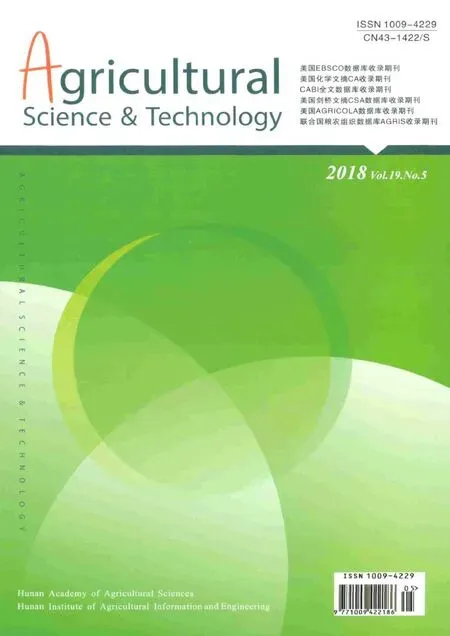New Low-cadmium Rice Variety of Hunan Hybrid Rice Research Center Passes CAASS Evaluation
This journal reported that on September 28th, 2018, a 15-member team of experts from the China Association of Agricultural Science Societies (CAASS), at the request of the Hunan Academy of Agricultural Sciences, evaluated the multi-site ecological experiment of the “Breeding of Low-Cd-Accumulation Rice Variety Project” led by the Hunan Academy of Agricultural Sciences and conducted by Hunan Hybrid Rice Research Center. LIU Yao-guang, an academician of the Chinese Academy of Sciences and professor of South China Agricultural University, was chosen as the team leader; Qian Qian (researcher atthe China National Rice Research Institute), LIU Bao-cun (researcher atthe Beijing Academy of Agricultural and Forestry Sciences), and LIU Zhong-qi (researcher at the Agro-Environmental Protection Institute, Ministry of Agriculture) were invited as the vice teamleaders. YUAN Long-ping, academician of the Chinese Academy of Engineering, also attended this meeting.
In order to improve the quality of scientific research, stimulate scientific innovation, and accelerate achievement transformation, the team appraised the progress of the research and made some constructive suggestions regarding program approval, research and development process, scientif ic innovation, and application prospect.
Cadmium (symbol: Cd) is a heavy metal hazardous to human health. In areas where Cd pollution has exceeded the allowable limit, rice shows a propensity to absorb and accumulate more Cd than soybeans and corn. In 2002, the Rice and Rice Products Quality Supervision and Inspection Center of the Ministry of Agriculture carried out a nationwide spot check to examine the safety of rice and its products, revealing a Cd over-limit ratio of over 10.3%. In 2007, Nanjing Agricultural University randomly purchased more than 170 rice samples from markets above the county-level in Eastern, Northeast, Central, Southwest, South, and North China. According to the testing results, 10% of the tested samples had excessive Cd contents.
Currently, the breeding of low-Cd rice varieties is the most cost-effective method of controlling Cd pollution in rice. There is, however, a long-existing technical problem: how to cultivate low-Cd rice varieties in paddies heavily polluted by cadmium. The research team achieved a major breakthrough in 2017 with the invention of “Cadmium Removal Technology for Hybrid Rice Parents” based on genome editing and heterosis utilization. With this new technology, researchers made specif ic changes to the main cultivar parents’ major Cd-adsorbing gene (OsNramp5) via CRISPR/Cas9 site-directed mutagenesis in order to block the absorption of Cd by rice, and developed a new cultivar suitable to grow in heavily-Cd-polluted paddies, namely, the high-yield, high-quality and low-cadmium hybrid combination — “Liangyoudige 1” and its parents “Dige 1” and “Dige 1S”. Experiments were conducted in heavily-Cd-polluted paddies (total Cd content: 1.5~2.4 mg/kg) in three provinces for two years. The above new cultivar presented a stable Cd-content of less than 0.07 mg/kg in its grains without compromising yield or quality, which was much lower than both the national standard (0.2 mg/kg) and the international standard (0.4 mg/kg).
In 2018, the research team was authorized to carry out pilot experiments in 8 Cd-polluted and naturallyisolated test fields in Beishan (Changsha, Hunan), Hekou (Xiangtan, Hunan), Junchu (Liling, Hunan), Hengnan (Hengyang, Hunan), Pingxiang (Jiangxi), Ganzhou (Jiangxi), and Jinzhou (Hubei). The aim of these multi-site ecological experiments was to verify the Cd-reduction effects and main agronomic characteristics of “l(fā)ow-Cd rice” under diverse soil types, various cadmium and manganese(symbol: Mn) concentrations, and different cultivation methods.
The team of expertsorganized by CAASS inspected these 8 test fields from September 25thto 27th, where Dige 1, Liangyoudige 1, and their control (Huazhan and Longliangyouhuazhan) were sampled for further investigation. According to the results, Dige 1 and Liangyoudige 1 had uniform and consistent populations. There was no signif icant differences in the main agronomic characteristics between the test material and their control, including plant height, plant and leaf pattern, and growth period. Excluding the site with a total Cd content of 25.2 mg/kg, the Cd contents of Dige 1 and Liangyoudige 1 were 0.03~0.09 mg/kg and 0.02~0.08 mg/kg, respectively, under certain field conditions (total Cd content: 0.53~1.46 mg/kg, total Mn content: 103~662 mg/kg, and pH value: 5.3~7.8), which were much lower than those of their control and the national limit (0.2 mg/kg).
With the support of the “Breeding of Low-Cd-Accumulation Rice Variety Project” and “The modern agricultural industry technology system”, and the instruction of YUAN Long-ping and BAI Lian-yang, this remarkable progress was achieved by ZHAO Bing-ran’s research team(Hunan Hybrid Rice Research Center) after 5 successive years of endeavor. ZHAO Bing-ran’s research team used the backbone parents of hybrid rice as acceptor materials and took the lead in establishing a rapid and accurate technical system for the breeding of low Cd-accumulation indica hybrid rice parents. On this basis, they created Dige 1 (low Cd-accumulation restorer line), Dige 1S (low-Cd-accumulation sterile line), and Liangyoudige 1 (low-Cd-accumulation hybrid rice combination). Field experiments have been conducted for many years at multiple sites moderately or heavily polluted by cadmium. The results have proved that the Cd contents in Dige 1 and Liangyoudige 1 are within the limit of food safety standards. This breakthrough offers promising potential for solving the problem of Cd pollution in rice grains in some areas of China.
ZHAO Bing-ran and LIU Zhong-qi reported the progress of the research and the test data of the Cd contents to the team of experts, who inquired about the mechanism of low Cd accumulation, the scientificity of the experimental design, the reasonability of the field sampling, the reliability of the testing method, the comparability of the testing results, the agronomic traits in the field, etc. The experts were satisf ied with the responses. This new rice cultivar has proved adaptable in Cd-polluted paddies and the Cd content in its rice grains is within the safety limit, indicating great socioeconomic benef its and broad applications potential. The experts suggested turning to the government for industrial, administrative and f inancial support, thus facilitating the application and extension of the product.

